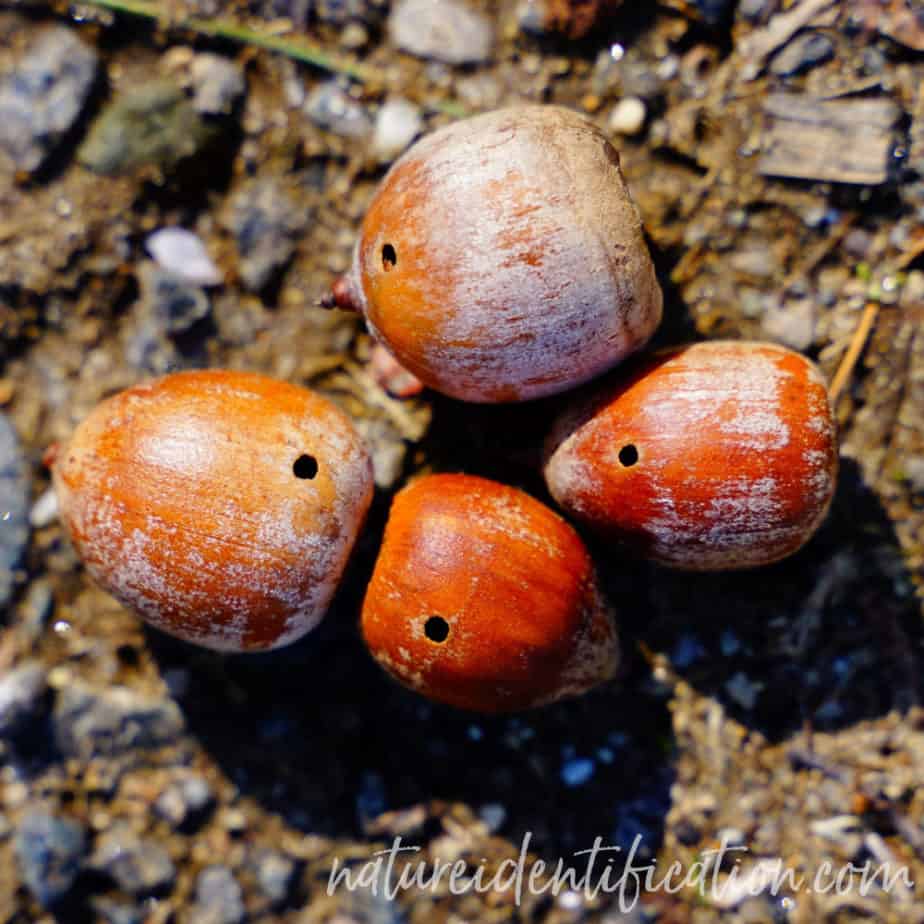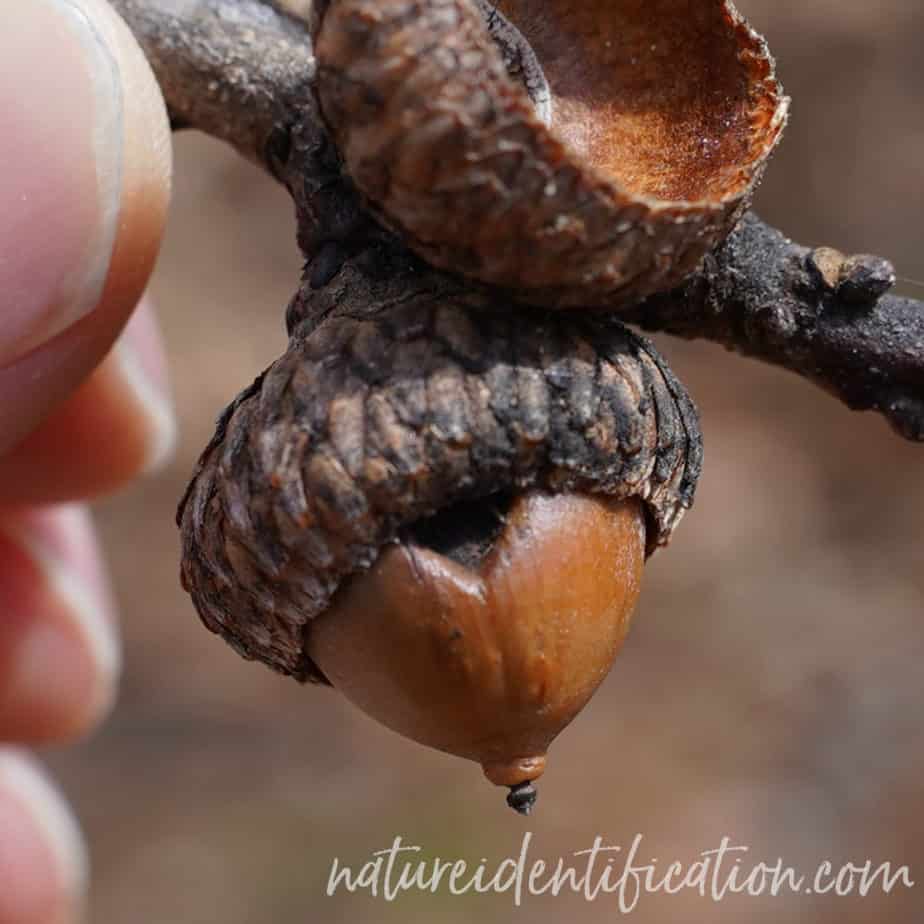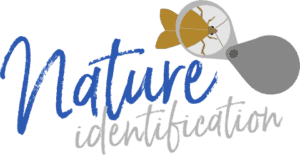So you’ve stumbled into an acorn with a hole in it and you want to know who made it? There are several creatures that will make visible holes in acorns and we will discuss 4 of the most common creators in this post.
Acorn and Nut Weevils

The emerging larvae of the acorn and nut weevils (Cucrulio sp.), a genus of beetles, make a nearly flawless circular hole about 1/8 of an inch in diameter into acorns. Acorn weevils are one of the most common consumers of acorns in oak forests in the United States and go after both red and white oak acorns.
As acorns begin to develop in late summer, a female adult weevil will lay 1 to 2 eggs into the green flesh of the acorn using her ovipositor; a tubular-shaped organ that cuts into the acorn and deposits an egg. The small hole created by the ovipositor will be healed over by the plant and the acorn will continue to develop normally; However, a visible brown scar will remain that can be seen when the acorns drop in early fall.
Acorns with a weevil egg will typically drop earlier than a healthy acorn, so early fall is a good time to look for acorns with the scar. (1) These “marked” acorns are usually avoided by squirrels as they prepare their caches for the winter. (2) This is possibly due to a lower nutritive value of the infested acorns (3) or perhaps an unpalatable taste!
The larvae of the weevil will hatch within 2 to 3 weeks and consume usually less than 50% of the meat during this stage – creating tunnels as it feeds. Acorns with two eggs may result in 100% loss of the acorn meat. Once the acorns are dropped to the forest floor, the characteristic larvae emergence holes become visible. The larvae leave the acorn and begin to bury themselves in the forest soil where they will go dormant for 1 to 2 years before emerging as an adult. (4)
Acorns that have been attacked by a singular acorn weevil may still germinate. Weevils often leave the acorn embryo and most of the meat intact; however, the resulting plant will grow slower and will not be as competitive as a plant from an acorn that was not attacked by a weevil. The acorn weevil is not considered a major pest species, but in locations where weevil populations are high, it’s possible that oak forest regeneration could be impaired as seed dispersal is reduced from fewer viable acorns. (5)
Pip Gall Wasps

The pip gall wasp (Callirhytis operator) lays an egg into a developing acorn; forming a gall on the side of the acorn. A gall is a unique plant structure that serves as both a food source and a shelter for the offspring of the gall maker. When the gall falls out, what remains is a triangular-shaped hole at the top of the acorn where it meets the cap or capule.
C. operator uses it’s ovipositor to lay an egg inside a maturing acorn similar to the acorn weevil, but unlike the acorn weevil, the wasp injects hormones alongside the egg into the acorn that results in the formation of a tooth-shaped gall. C. operator lays it’s eggs in second year red oak acorns around June, and the gall will develop over the following month or two. Unlike white oak acorns which take a single year to develop, red oak acorns take two years to develop. Acorns infested with the C. operator will typically drop their acorns prematurely similar to acorns infested with weevil eggs, so if you see an acorn that dropped early (such as in summer), look for evidence of these creatures! (6)
Once on the ground, the acorn will soften and the pip gall will usually fall out of the acorn – leaving the distinctive hole. The development of the wasp larvae will continue inside the gall on the forest’s floor. (7) Unfortunately, the acorn is not usually viable after being attacked by C. operator
Mice

Mice produce a large access hole on one side of an acorn that allows the mice the extract all of the acorn meat, without breaking the acorn shell into pieces. For many animals, the meat of an acorn is a high-fat and nutritionally dense food, but the exterior shell is not edible – so this needs to be removed. The hole created by the mouse extracting the acorn meat will be slightly jagged at the edge from their incisor teeth carving into the shell to create the hole and there may be evidence of incisor teeth scratches in the interior of the shell as well. Look for these acorns in tree cavities, under fallen logs, buried in leaves, or anywhere a mouse might be sheltered and feel safe for a snack! (8)
Mice feed on acorns differently than other rodents. Chipmunks, ground squirrels, and tree squirrels all feed on acorns, but all of these other rodents will break the shell up into multiple pieces. Generally, the number of pieces the acorn is broken up into is correlated with the size of the animal. If the shell is broken up into only a few large slivers, then it was likely done by a larger rodent such as a gray squirrel. If the shell was broken up into many small pieces, then it was likely done by a smaller rodent such as a chipmunk. (9)
Larger acorn pieces = larger animal
Smaller acorn pieces = smaller animal
This rule is obviously broken with mice with their distinctive extraction hole!
Birds

Various birds will “crack” a hole into acorns to extract both acorn meat and bugs (like the acorn weevil). The hole left by birds will have a shattered appearance as they are breaking into the acorn with their beak. The lack of a rounded edge is what differentiates these holes from mice extraction holes. (10)
Also unlike rodents, birds will only extract what they need to out of the acorn, whether it’s a bug or a couple bites of acorn meat, and then leave. The resulting hole isn’t very pretty!
Birds that might make an extraction hole similar to the ones pictured include jays, nuthatches, and woodpeckers. Differentiating these birds by holes without behavioral or environmental clues may be difficult.
